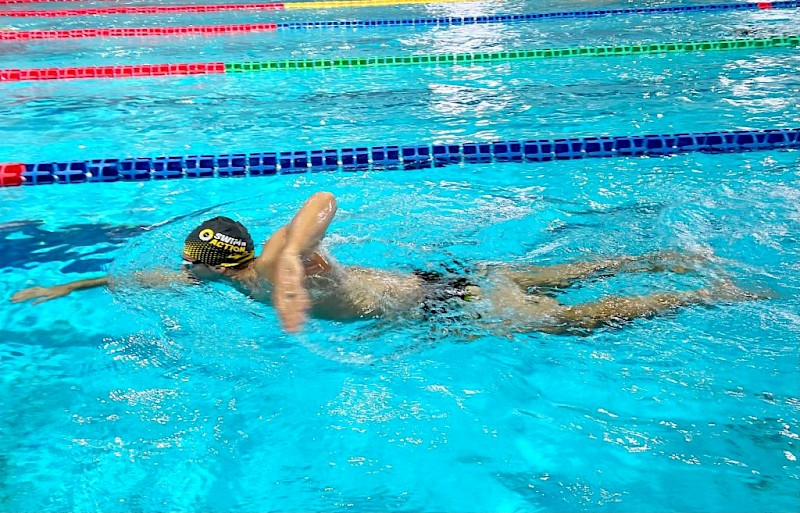There are two schools of thought regarding the position of the head in freestyle: those who say it must be raised to allow you to look forward and those who say absolutely not. This is the definitive article for clarity.
Raising the head is one of the most common freestyle mistakes.
This postural problem is usually related to normal frontal gaze: in fact, it is not human nature to move without looking in the direction you are moving. And when we swim freestyle, it is therefore natural to try to look forward, and to do this we have to lift our head. This 'vice' affects both swimmers training in the pool for pool races and those training for open water races, including triathletes.
What are the reasons?
Swimming in a pool involves postural habits dictated by the risks of the environment: when there are many people in the lane, it is inevitable to raise your head to see where you are going, to avoid someone, to overtake someone, or not to lose your wake if you are working in a group.
Other reasons may be related to a lack of confidence and calmness in the water, or a strong belief that keeping your eyes forward and head up is the correct position to adopt in open water. In fact, keeping the head in a horizontal position often gives a sense of 'falling', as if we cannot control the balance of our body. As a result, since we cannot find solid reactions with the support of our hands on the water (because they are pressing on a liquid), we tend to raise our head, reducing the effectiveness of the first two phases of the stroke (support and pull) and almost completely neutralising the pushing phase!
Consequences
Once the reasons and justifications have been identified, we move on to the consequences.
Swimming forward is similar to walking upward: in both cases, the lifting of the head has a drastic effect on posture. This is because the head is the heaviest part of the human body, so its displacement on the median axis during forward swimming affects both posture and forward movement.
More specifically, when we lift our head during freestyle swimming, it happens that:
- The weight of the head affects the lumbar region, which tends to become hyperlordosed, with a consequent "deactivation" of the abdominal wall;
- the pelvis tends to sink and, to compensate for this, the legs intervene, but often in "land mode", i.e. with the knee too bent and the ankle too stiff: a mode that is not very effective in the water.
The domino effect triggered degenerates into a loop that leads to rigidity of the entire upper quarter of the body (neck, shoulders, upper back area), with consequences on breathing, blockage of the shoulder blades, rolling (almost zero), shoulder joint and pain in the trapezius area.
Strategies and interventions
Of course, each swimmer needs an individual course, but we can say that in most cases a different weight balance is required. So when we swim freestyle, we have to take the same dynamics on land (head from vertical to horizontal) and adapt them to the water.
How can we change the head position from vertical to horizontal? How can we get rid of this habit?
By giving ourselves instructions that focus on the effect we want to achieve, rather than on correcting the gesture itself (which would be too theoretical). So, for example, we can concentrate on looking at the line below (rather than simply telling ourselves to 'lower the head').
What about when we swim in open water?
Of course, each swimmer needs an individual course, but we can say that in most cases a different weight balance is required. So when we swim freestyle, we have to take the same dynamics on land (head from vertical to horizontal) and adapt them to the water. In the sea or in a lake (or anywhere else that is not tiled and demarcated), look for landmarks outside the water's surface, such as buoys or landmarks on dry land that are easily visible from the water's surface and that correspond to the route to be taken (coloured houses, trees, details in the ground...). They are identified by raising your eyes above the surface of the water.
Simply looking ahead, but underwater, avoids unpleasant contact with those in front of you, but as there are no landmarks in the pool (black line underwater, paths, tiles...), it would be useless and harmful to maintain this head position all the time. It is therefore necessary to acquire and practise the ability to partially raise the head (in fact, only the eyes) for the minimum time necessary to identify the landmarks (one or two strokes, not necessarily consecutive) and, if necessary, to adjust the path to be followed.
Two final considerations
Unfortunately, there is no official training in swimming technique, and coaches often have different ideas about it. As a result, the search for and development of correct biomechanics often takes second place to the quest for performance through conditional training and volume, which leaves little room for technique. Unfortunately, this happens at all levels, from amateur to elite.
How can we change the head position from vertical to horizontal? How can we get rid of this habit?
By giving ourselves instructions that focus on the effect we want to achieve, rather than on correcting the gesture itself (which would be too theoretical). So, for example, we can concentrate on looking at the line below (rather than simply telling ourselves to 'lower the head').
